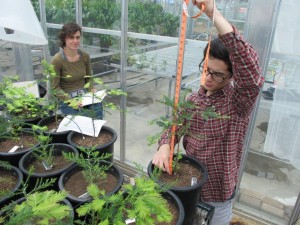
Last week, I spent some time wondering broadly about our recent RCCI results, and just whether we could say for certain that 1) climate change is spurring an increase in redwood growth, and 2) if that change is “good” for the redwood forest. This week, I’d like to look a bit closer at some of the individual results to try to understand just what they mean and the new questions and opportunities for further study that they raise.
The team of researchers from UC Berkeley focused in part on climate change’s impacts at the physiological level of individual trees. In one experiment, led by Dr. Anthony Ambrose, seedlings of coast redwood and giant sequoia were subjected to periods of controlled drought followed by a well-watered recovery period aimed at assessing both the impacts of water deficit on seedlings as well as their capacity to respond to a drought’s end. The results were a mixture of the expected and the surprising. Giant sequoias showed a greater overall drought tolerance (they were able to photosynthesize more and their growth slowed less) than coast redwoods. Given that giant sequoias grow in the Sierra Nevada – a higher, drier landscape than that inhabited by the coast redwood), this finding is in line with what we might intuitively expect. As more supporting evidence, the same study found that giant sequoia seedlings have larger root systems than do coast redwoods, possibly indicating a greater ability to access subsoil water.
Less predictable, though, was the study’s finding that seedlings from different parts of their ranges showed similar responses to both the experimental drought and recovery period. Given that the range of coast redwood stretches for over 400 miles north-south, I for one would have expected there to be some difference in their tolerance for dry conditions, with seedlings from the south and east (the drier areas) more able to undergo dry periods than their relatives from the wetter northern and coastal areas. How could this be? A clue to a possible answer can be found in another RCCI project. Historical climate analysis showed not only that California’s climate has warmed in recent decades, but that precipitation is and, more importantly was, highly variable. If we would expect trees from different parts of their range to respond differently to drought because they have adapted to certain levels of rainfall, then it stands to reason that we should expect trees adapted to unpredictable (on the timescale of an ancient tree) rainfall patterns to adapt to that variability and retain the capacity to endure changing conditions.
So what does all that mean? Is it good news or bad news? On one hand, it means that redwoods from the driest parts of their range are no better adapted to dry conditions than those from the wettest. On the other hand, however, even those redwoods from the rainforests of Humboldt and Del Norte counties are as able to respond to drought as those from Big Sur. While RCCI’s climate trends analysis has shown that the central and southern redwood forest is likely to experience significant changes in temperature, will redwoods’ ability to respond to drought be enough to withstand them? One worrisome fact is that both coast redwood and giant sequoia show a threshold response to drought (meaning that they do just fine until a certain level of dryness, then decline rapidly), and so we may not know of a problem until it is already upon us.
Like any good research, this experiment raises many more questions than it answers. Because redwoods are really big and hard to move, these experiments were performed with seedlings, generally thought to be trees’ most vulnerable life history stage. Do mature trees react the same way? Does their ability to adapt decline with age, or is it fixed? How does the intensity (how little water is available) of the drought matter relative to the duration (how long between rain events)? A century of growing redwoods in New Zealand – where fog is not a major influence – might suggest that the timing of rainfall rather than the sheer amount is the factor that best helps determine how well redwoods grow. Perhaps, so long as there is water at critical times of the growing season, that may compensate for an overall decrease in available water. These are but a few of the questions we will hope to answer as we continue the initiative, and there will doubtlessly be many more to come.
Learn more and see the recent RCCI results.




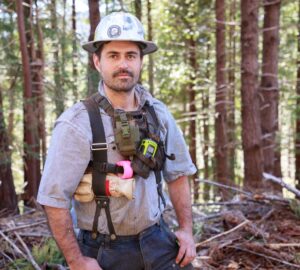

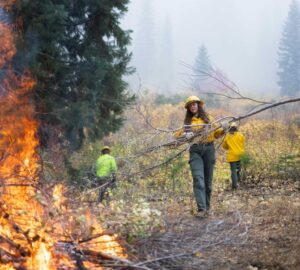
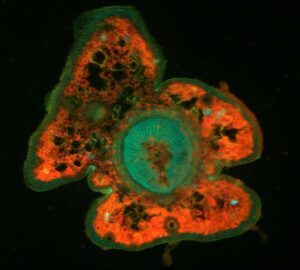
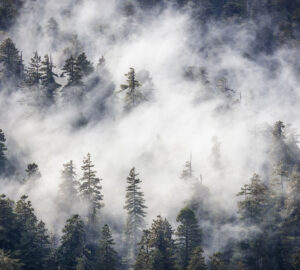
3 Responses to “The Seedling-Drought Experiment and Its Surprising Result”
teamredwood
Great reply, I really enjoy your post-keep them coming!
Thank you,
Grant
Richard Campbell
Those are some really good questions, and I wish I had definitive answers for you…
Since basal sprouts by definition grow in the same spot as an existing tree, i’m not sure that they would cause the sort of infilling you mention. Basal sprouts are often a response to stress (such as wounding or drought), so we may well see more sprouting in the forests if conditions do become drier. Whether or not that increases competition for water will depend on how dry it becomes. Right now, the limiting factor in many of these forests seems to be light, but that may change. That said, since small trees (even sprouts with large root systems) need less water than large trees, that competition probably wouldn’t impact old-growth trees too much until the sprouts themselves grew into large trees (how large they would have to be would of course depend on where they were and how many there were).
Regarding your thoughts on studying forests near roads, an excellent example of this is the 101 corridor near the Eel River. Many ancient trees have suffered dieback at their tops since development of the highway, and one possible explanation is a combination of altered groundwater (meaning the roots are able to drink less) and increased wind at the top (meaning that the trees lost more water through their needles).
This is definitely a fascinating topic, and I for one and very interested to see what insights our future research will bring.
teamredwood
Great information, thank you.
It would be interesting to find out if drought conditions, like post fire recovery, encourage more basal sprouts (using existing root systems).
As climate change progresses, it might promote more ‘infilling’ in the established forests-by greater production of basal sprouts vs. seedlings.
Do you think that this might increase the competition for water between the new sprouts and old-growth trees?
Also,maybe studying trees that are growing near paved roads -with decreased humidity near the floor of the forest due to heat-island effects and increased wind impact-might be a good indication of how the trees will react to a drier climate in the future.